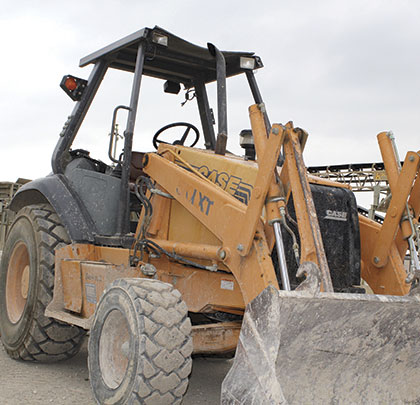Construction tires have undergone a revolution in recent years, with the introduction of new tread patterns and features to improve performance and tire life as challenges on the jobsite have become more intense. Whether dealing with broken pavement, mud, or abrasive surfaces—successful tire engineers need to be designing tires for tough environments on an ever-growing array of machinery rather than expecting contractors to settle for a one-size-fits-all solution.
Until now, most construction-ready tread patterns have only been available on air-filled pneumatic tires, which are amazingly durable, but still subject to punctures in extreme conditions. With the development of solid tires purpose-built for construction applications, contractors’ options just got much broader. The new solids bring the durability enjoyed by waste management equipment operators and mining crews to construction machinery.
STILL PUMPED
Air-filled pneumatic tires remain the most popular choice among construction contractors. They are comfortable for operators, come in a wide variety of tread patterns and ply ratings, minimize wear on equipment, and are generally the least expensive option.
The flexible sidewalls of pneumatic tires act as shock absorbers, reducing bumps, jolts, and vibration that can add to worker discomfort and fatigue and batter equipment. Radial tires have more flexible sidewalls than bias-ply tires do and tend to be able to operate at higher speeds. That makes them well suited for machines that will spend a lot of time in transit over the road, but more susceptible to sidewall puncture.
Maintaining proper inflation pressure ensures that tires perform at their best. The footprint of the tire, resistance to puncture or rupture, flex of the sidewall, heat generated during operation, and grip of the tire’s bead on the rim are all optimized by proper inflation pressure. Check inflation pressure at least once a week and adjust as needed for conditions, temperature, and load, using the tire manufacturer’s load inflation chart for guidance.
A LITTLE CUSHION
Filling pneumatic tires with urethane foam is an option for reducing flats on equipment where tire punctures are common. Foam-filled tires behave more like solids, with a harder ride than the floating-on-air cushion of a pneumatic tire. Foam is also surprisingly heavy, multiplying a tire’s weight by two to three times. This added weight can reduce machinery efficiency and may strain the drivetrain of low-powered equipment, so make sure you take it into account when considering foam fill for existing tires.
SOLID OPTIONS
Solid tires have long been used in mines, metal scrap yards, and waste handling facilities, where punctures are guaranteed to be a problem. They are also used in warehouses and dairy farms, where hard turns and constant operation on concrete surfaces wear tires down quickly. Traditionally limited to a few low-traction tread patterns, most solid tires in the past were a poor fit for construction equipment.
Now, contractors can get the benefit of solid tire construction with traction treads. The Galaxy Severe Duty Solid (SDS) line was launched about a year ago with the tried-and-true Beefy Baby SDS bar tread pattern. The line was recently extended with the Galaxy Hulk SDS, which introduced a massive block tread that blends traction with abrasion resistance, making it ideal for skid steers that transition between pavement and mud. The LHD 500 SDS adds a solid version of a classic, large lug pattern loader tire, with a flat tread radius for longer wear. For environments where durability is crucial but traction is not an issue—for instance, big commercial projects where skid steers or loaders spend months operating on concrete slabs—the Galaxy Super Smooth SDS offers a long-lasting option.

Featured Image: These popular pneumatic Galaxy Hulk tires are now also available as solids, part of a move to provide greater variety in severe-duty solid tire choices.
Above: The Galaxy Hulk has proven itself a durable tool on construction sites, especially where equipment works on both pavement and mud.
The last solid tire in the construction SDS lineup (so far) is the Galaxy Yardmaster, a loader and forklift tire with huge rubber-to-void ratio to increase wear resistance and three-stage construction, in which a cellular center compound provides a cushioning effect.
Where punctures and scrubbing have cost some contractors countless dollars in lost tires, solid tires can be a great investment, often doubling or tripling tire life compared to pneumatics. Many solids may be retreaded, further adding to tire life. And, as experienced labor gets harder to find, tire damage from inexperienced operators is likely to increase. Solid tires can be a hedge against expensive learning curves, as well as provide a way to minimize downtime when schedules are tight and bonuses are at stake.
COST OF OWNERSHIP
The ultimate measure of success with a tire is the cost of ownership. Purchase cost is easy to figure. Service life is the next major factor, adding in the additional hours—and cost—of retreading. Don’t forget to factor in the cost of downtime while a machine is out of service awaiting flat repair or a new set of tires, which includes lost productivity of the machine, ownership costs, and wages/benefits of the operator.
There is no one-size-fits-all “right answer”—the total cost of ownership of a tire is as individual to you as your business is. The good news is that there is a wide variety of application-specific, purpose-built tires on the market, so although there is no single solution that makes sense for every environment, there is definitely a tire built for any challenge you are facing. Talk to your tire dealer, think through your jobsites, your needs and your budget, and take advantage of the great tire choices that are now available. ■
About the Author: Seth Walters is manager, special product programs for Alliance Tire Americas. For more information on Galaxy tires or Alliance Tires’ Alliance and Primex brands, visit www.atgtire.com.
_________________________________________________________________________
Modern Contractor Solutions, February 2017
Did you enjoy this article?
Subscribe to the FREE Digital Edition of Modern Contractor Solutions magazine.

Solid Choices for Construction Tires


